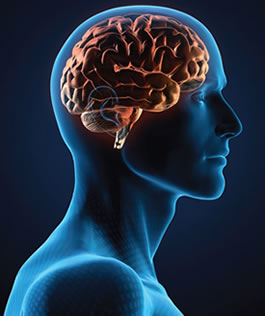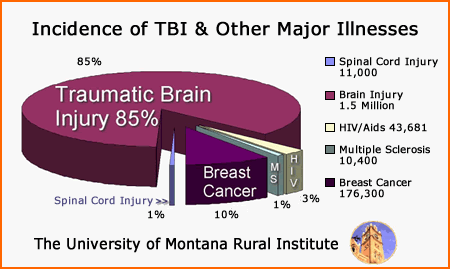 Here are a few brain injury statistics that reveal just how enormous of an issue brain injury has become, locally, provincially, nationally and internationally.
Here are a few brain injury statistics that reveal just how enormous of an issue brain injury has become, locally, provincially, nationally and internationally.
Of all types of injury around the world, injuries to the brain are among the most likely to result in death or permanent disability. In fact, brain injury is currently a leading cause of death and disability worldwide.
The annual incidence of acquired brain injury in Canada is 44 times more common than spinal cord injuries, 30 times more common than breast cancer, and 400 times more common than HIV/AIDS. In fact, brain injury occurs at a rate greater than that of all known cases of Multiple Sclerosis, Spinal Cord Injury, HIV/AIDS and Breast Cancer per year combined.
Brain injury receives far less funding nationally than any one of the above issues does provincially.
452 people suffer a serious brain injury every day in Canada. This amounts to one person injured with a traumatic brain injury every 3 minutes.
Brain Injury occurs at a rate of 500 out of 100,000 individuals yearly in Canada. From a population of 33,000,000, that translates to 165,000 serious brain injuries per year (rate does not include concussions – or mild traumatic brain injury, military injuries, or unreported cases).
Of those, tens of thousands of become partially or permanently disabled, and more than 11,000 Canadians die.
Brain injury claims thousands of times more victims every year than all flu and cold viruses combined, yet brain injury nationally receives far less funding than Nova Scotia spends annually on flu vaccinations.
One in three Canadians is directly impacted by brain injury in some way.
The incident rate of brain injury in British Columbia, according to the BC Brain Injury Association, is approximately 60 new cases per day, or 22,000 cases of serious brain injury every year. Add them to the 180,000 plus survivors in British Columbia currently living with severe acquired brain injury, and it is quickly apparent that British Columbia is experiencing a epidemic.
Acquired brain injury is the leading cause of death and disability for Canadians under the age of 40. In fact, 30 percent of all brain injuries in Canada are suffered by children and youth, with acquired brain injury the leading cause of death and disability among children.
Estimates put the brain injury rate among First Nation peoples at 4-5 times the rate of the general population.
Experts agree patients who experience an acquired brain injury are at increased risk of depression and post traumatic stress disorder (PTSD).
 Untreated brain injury often leads to ‘self-medication’ using substances, drugs and alcohol.
Untreated brain injury often leads to ‘self-medication’ using substances, drugs and alcohol.
Self-medication often leads to crime.
Experts estimate that 60-80% of people in prison have untreated acquired brain injuries, most injured before ever committing a crime.
Survivors of a brain injury are at a three times greater risk of experiencing a second brain injury, and face an eight times greater risk of sustaining subsequent other injuries as a result of their initial injury.
Acquired brain injury is the leading cause of seizure disorders.
You don’t have to be knocked unconscious to sustain a brain injury. Mild acquired brain injury (MABI), also known as concussion, can damage the brain at the cellular level.
Each severe brain injury costs our medical system over $1,000,000 at the time of injury. Costs remain approximately $400,000 each year following the incident due to indirect expenses and follow-up treatment.
The economic burden of acquired brain injuries and treatment, when combined, is estimated to be greater than $12.7 billion per year.A 2009-10 study found that more than half of Toronto’s homeless population had a acquired brain injury. Even more concerning, was that for 70 percent of those surveyed, the first acquired brain injury occurred before becoming homeless.
22% of people who survive catastrophic brain injuries will never leave their homes.
In Ontario, 92% of men, and 100% of women who sustain brain injury, NEVER return to full-time employment.
Today, we are content to refer to brain injuries as ‘getting your bell rung’, ‘seeing stars’, or some other euphemism which trivializes and minimizes the harm that blows to the head causes. Ten years ago we might have pleaded ignorance. We didn’t know about the damage these blows to our children’s heads were causing. Today we have the medical evidence that shows how bad the really news is, and unfortunately, that much of the damage is irreparable.
All misconceptions aside, every single hour, twenty Canadians will suffer a brain injury. The horrifying reality is that 90% of all of those injuries would never have happened to begin with, if we had simply invested money into education and prevention, because the only known cure for brain injury is prevention.

![By Ed Yourdon (originally posted to Flickr as Homeless and cold) [CC-BY-SA-2.0 (http://creativecommons.org/licenses/by-sa/2.0)], via Wikimedia Commons Photo By Ed Yourdon](http://nbia.ca/wp-content/uploads/2014/03/homeless-man.jpg)
